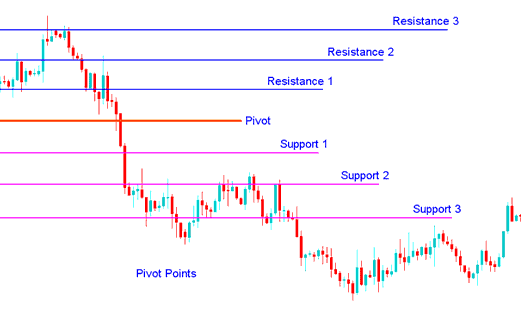Stocks Pivot Points
Pivot points is a set of indicators developed by floor traders in the commodities markets to determine the potential turning points, also known as "pivots". These points are calculated to determine levels in which the sentiment of the trend could change from "bullish" to "bearish." traders use these points as markers of support and resistance.
These points are calculated as the average of the high, low & close from the previous session:
Stocks Pivot Point = (High + Low + Close) / 3
Day traders use the calculated pivots to determine levels of entry, stops & profit taking, by trying to determine where the majority of other traders may be doing the same.
A pivot is a price level of significance in technical analysis of a financial market that is used by traders as a predictive indicator of price movement. It's calculated as an average of significant prices (high, low & close) from the performance of a market in the prior period. If the prices in the following period trades above the central point it is usually evaluated as a bullish sentiment, whereas if price below central point is seen as bearish.
The central point is used to calculate additional levels of support and resistance, below & above central point, respectively, by either subtracting or adding price differentials calculated from previous ranges.
A pivot and the associated support & resistance levels are often turning points for the direction of price movement in a market.
- In an up trend, the pivot point & the resistance levels may represent a ceiling level for the price. If price goes above this level the up trend is no longer sustainable and a trend reversal may occur.
- In a down trend, a pivot point & the support levels may represent a low for price level or a resistance to further decline.
The central pivot can then be used to calculate the support & resistance zones as follows:
Pivot points consist of a central point level surrounded by three support levels below it and three resistance areas above it. These points were originally used by floor traders on equity and futures exchanges because they provided a quick way for those traders to get a general idea of how the market was moving during the course of the day using only a few simple calculations. However, over time they have also proved exceptionally useful in other markets as well.
One of the reasons they are now so popular is because they are considered a "leading" (or predictive) indicator rather than a lagging indicator. All that is required to calculate the pivot points for the upcoming (current) day is the previous day high, low, and close prices. The 24-hour cycle pivot points in this indicator are calculated according to the following formulas:
The central pivot can then be used to calculate the support & resistance zones as follows:
Resistance 3
Resistance 2
Resistance 1
Pivot Point
Support 1
Support 2
Support 3

Pivot Points Support and Resistance Levels
Pivot Points as a tool
The pivot point itself represents a level of highest resistance or support, depending on the overall sentiment. If the market is direction-less ( range bound ) prices will often fluctuate greatly around this level until a price breakout develops. Prices above or below the central point indicates the overall sentiment as bullish or bearish respectively. This indicator is a leading indicator that provides signals of potentially new highs or lows within a given chart timeframe.
The support and resistance levels calculated from the central pivot point & the previous market width may be used as exit points of the open trades, but are rarely used as entry signals. For example, if the price is up-trending and breaks through the pivot point, the first or second resistance level is often a good target to close a position, as the probability of resistance and reversal increases greatly, with every resistance level.
In pivot-point analysis 3 levels are commonly recognized above & below the central point. These are calculated from the range of price movement in previous period & then added to the central point for resistances and subtracted from it for support areas.
Pivot Points
Pivot levels can be used in many different ways. Here are a few of the most commonly methods for utilizing them:
Trend Direction: Combined with other Stocks analysis techniquesmethods such as oversold/overbought oscillators, volatility measurements, etc., the central point may be useful in determining the general trending direction of the market. Trades are only taken in direction of the trend. Buy trades occur only when the price is above the central point & sell trades occur only when the price is below the center pivot point.
Price Break Outs: In price breakouts, a bullish buy signal forms when the price breaks up through the central point or one of the resistance levels (typically Resistance Area 1). A short sell signal occurs when price breaks down through the center point point or one of the support levels (typically Support Area 1).
Trend Reversals: In trend reversals, a buy signal forms when the price moves towards a support level, gets very near to it, touches this point, or moves only slightly through this point, & then reverses and starts moving in the other direction.
To download Pivot points Indicator:
https://c.mql5.com/21/9/pro4x_pivot_lines.mq4
Once you download it. open it withthe MQL4 Language MetaEditor, Then Compile the indicator by pressing the Compile Button Key and it will be added to your Meta Trader 4.
NB: Once you add it to your Meta Trader 4 Software, the indicator has additional lines named Mid-Points, to remove the extra lines open the MQL4 MetaEditor(short cut key-board key - tap F4), & change line 16 from:
Extern bool midpivots = true:
To
Extern bool midpivots = false:
Then Press Compile button again, and it will then appear as highlighted on www.tradeforextrading.com web site.


